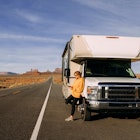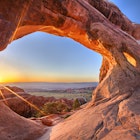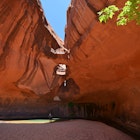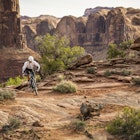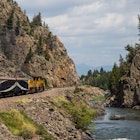A mind-boggling glimpse into layers upon layers of Earth’s planetary past, Canyonlands National Park is Utah's largest – and least visited – national park, even though part of it sits a short distance away from Arches National Park, a 40-minute drive from the town of Moab.
Canyonlands’ meandering cliffsides are stacked with thousands of feet of tie-dye-colored rocks that reach so far down, their sheer vertical walls make it difficult to see their powerful aquatic creators: the serpentine Colorado and Green Rivers. Overlooks into this grand expanse are accompanied by even more natural wonders: curious needles of rock emerging from the desert floor and geological anomalies that scientists have yet to fully figure out, as well as beauty created by the human hand in the form of ancient structures and Native petroglyphs.
The Colorado and Green Rivers form a Y-shape that divides Canyonlands National Park into four separate districts: Island in the Sky, the Needles, the Maze and the rivers themselves. The three land-based districts are inaccessible to one another from within the park, meaning that long drives are required to see each of them. Island in the Sky is the most visited district because of its proximity to Moab and the entrance to Arches National Park, both about 30 miles from the visitor center.
Ready to explore Utah’s wild side? Here’s a first-timer’s guide for making the most of your visit to Canyonlands National Park.
When should I go to Canyonlands National Park?
Spring and fall are the best times to visit Canyonlands National Park, but these seasons are also the busiest – though that’s a relative term compared with the other "Mighty 5" national parks in Utah. May is generally the busiest month at Canyonlands (particularly over Memorial Day weekend at the end of the month), followed by April and October.
Temperatures in this national park vary wildly – even as much as 40ºF in a single day. Canyonlands has few trees and little shade, so visiting in summer can be dangerously hot. During these arid months, the thermometer often rises past 100ºF by the afternoon, so it’s best to set off on hikes as early as you can. Winters are extreme in the opposite direction, and the temperature can plunge far below freezing. January is the least busy month at Canyonlands.
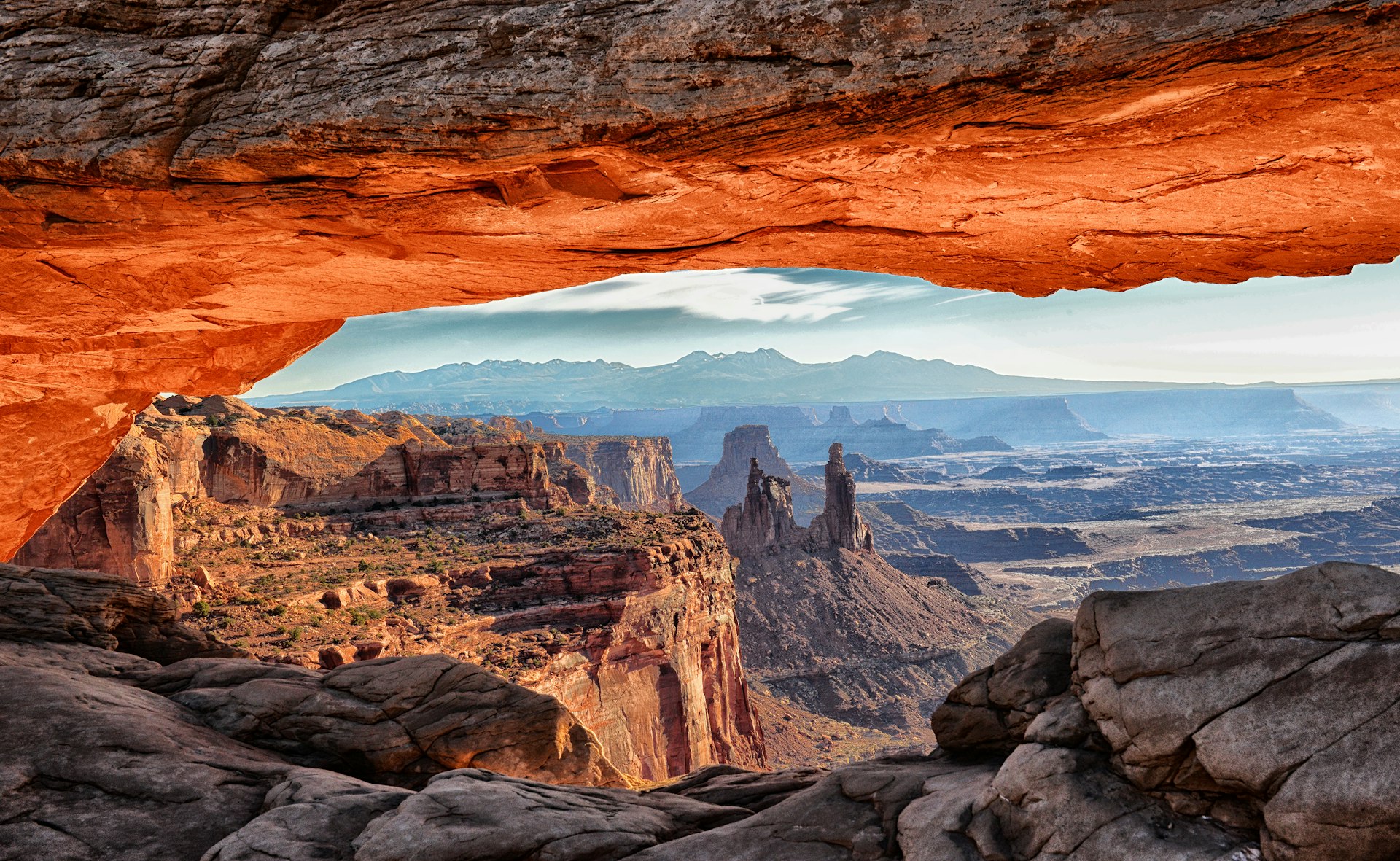
How much time should I spend at Canyonlands National Park?
At a push, Canyonlands’ Island in the Sky district can be seen in half a day, but it’s worth dedicating far more time to this awesome park. If you have only a day to spare, you could whizz through Arches National Park and Canyonlands National Park from Moab, spending half a day at each.
Start at the Island in the Sky Visitor Center and weave your way along the mesa-top scenic drive, pausing at viewpoints along the way. Worthy stops include Shafer Canyon Overlook, where you can watch Jeeps crawl down the switchbacks of Shafer Trail; Mesa Arch Trail, an easy half-mile round-trip hike to a 27ft-long rock arch on a cliff edge; and the too-humbly-named Grand View Point, one of the Southwest's most sweeping views, where the road ends.
If you want to visit the other districts of Canyonlands National Park, you’ll need more time. From Island in the Sky, it's a two-hour drive south to the Needles through Moab – and that’s just enough time to arrive, not to explore. The Maze district is the most remote and requires a 4WD vehicle and self-sufficiency. Many travelers stay in this area for a minimum of three days. Rafting on the rivers is also a multiday adventure, best arranged with adventure tour operators in Moab.
Is it easy to get to and around Canyonlands National Park?
Yes, it is easy to get to and around some parts of Canyonlands National Park – if you have a car. None of Canyonlands’ districts have public transportation or shuttle services.
The Island in the Sky district is the easiest to reach because of its proximity to Moab (about 30 miles away), but you’ll need a high-clearance 4WD vehicle to explore off the paved roads.
The Needles district is also easy to reach, but it receives only half as many visitors as Island in the Sky because it's further from the interstate – but still only a 1½-hour drive from Moab – and there are fewer roadside attractions (but most are well worth the hike).
The Maze district is the remotest area of Canyonlands National Park and requires self-sufficiency, navigational know-how and a suitable 4WD high-clearance vehicle to explore.

Top things to do at Canyonlands National Park
Island in the Sky is all about the views, and you'll comprehend distance in new ways standing on the 6000ft-high mesa that drops precipitously on all sides, providing some of the most captivating vistas in the country. Nearby Dead Horse Point State Park, on the same highway that heads to the national park, is another spectacular place to survey the scene.
Island in the Sky has a few worthwhile hikes, including seeing Mesa Arch at sunrise, which makes it glow a fiery red. Upheaval Dome is a must for geology nerds; scientists still aren’t quite sure what caused this crater. For drivers with high-clearance 4WD vehicles, the scenic Shafer Trail and Potash Road make classic Canyonlands adventures.
The Needles district – named for the spires of orange and white sandstone that appear to grow from the desert – is so different from Island in the Sky that it's hard to believe they're part of the same national park. Get among these bizarre formations by hiking the Chesler Park Loop, an 11-mile route across grasslands, past towering red-and-white-striped pinnacles and through slot canyons, some only 2ft across.
If you don’t have time for a full-day hike, check out cowboy artifacts and historic Native pictographs on the Cave Spring Trail or see if you can spot tiny water organisms in the small, rain-filled pools on the Pothole Point Trail.
Exploring the Maze is all about getting off-grid, and rafting the Colorado and Green Rivers promises another beautiful perspective on the remote corners of Canyonlands National Park.
My favorite thing to do at Canyonlands National Park
Canyonlands boggles the mind with its unending vistas from Island in the Sky, but on my most recent trip to this national park, I wanted to feel closer to the canyons and understand more of this land’s Native history. Horseshoe Canyon is nicknamed the "Louvre of the Southwest" for its huge panels of pictographs painted many millennia ago, and it’s one of the most impressive collections of rock art in North America.
The highlight is the 200ft-long Great Gallery, where an astonishing 80 human figures were painted in brown, red and white on a huge rock wall between 2000 BCE and 500 CE, though they might be older. I gasped when I spotted the haunting 7ft-tall figure at the center of the scene, known as the Holy Ghost. This type of art is called Barrier Canyon style (the former name of Horseshoe Canyon), and the meaning of the figures isn't fully known. Similarly styled clay sculptures found in the area date back more than 7000 years, meaning that this rock art could be twice as old as the Great Pyramid of Giza in Egypt.
The Horseshoe Canyon hike – and the drive to get to the trailhead – aren’t for the faint of heart. Reaching the start of the hike requires driving for at least an hour on dirt roads that can be extremely rutted and washboarded. If the weather has been good (i.e. not rainy), you can usually make it in a standard sedan – I did it in a Nissan Altima – but find out about road conditions before you set off. My car wasn’t particularly pleased with the journey, and the undercarriage got a sand bath for several miles.
The Great Gallery lies at the end of a 7-mile round-trip hiking trail that descends 780ft from a dirt road, built by the Phillips Petroleum Company in 1929 to supply its oil wells. Plan on six hours. National park rangers lead guided hikes most weekends in April, May, September and October. Check Canyonlands’ online park calendar for specifics, but otherwise, no park rangers are present on site.
Horseshoe Canyon is possible to visit as a long day trip from Moab, but it means spending at least five hours in the car to get there and back. The towns of Green River and Hanksville are closer to Horseshoe Canyon than Moab, but they are both still more than an hour’s drive.

How much money do I need for Canyonlands National Park?
The standard entrance pass for Canyonlands National Park costs $30 per vehicle, and it’s valid for seven days. If you’re visiting more national parks on a road trip through Utah and beyond, it’s worth buying the America the Beautiful pass for $80. It's valid for a year at all national parks and federal recreation land across the country for one vehicle or four per-person entry fees – arguably one of the best travel deals available.
Island in the Sky has a campground ($15 per night), as does the Needles ($20 per night). Both districts and the Maze have backcountry camping areas, which require a $36 overnight backcountry permit, plus $5 per person per night. The permits, bookable on recreation.gov, are bought up far in advance in the busy spring and fall seasons.
What is the closest city to Canyonlands National Park?
Moab is the closest town to Canyonlands’ Island in the Sky district, about 33 miles away. The town of Monticello is closest to the Needles district, about 55 miles south of Moab.
The Maze and Horseshoe Canyon are more remote, closer by road to Capitol Reef National Park than Arches National Park and Moab. Look for supplies and accommodations in Green River and Hanksville or stock up in bigger cities on the way in.
Where’s the best place to stay near Canyonlands National Park?
If you don’t want to camp, you’ll find cozy places to stay in the gateway towns near the entrances to Canyonlands National Park. For the Island in the Sky district, stay in Moab, which has lots of hotels lining its main street. Field Station is one of our favorite spots in town for its motel-turned-minimalist-mod vibes and adventure ethos.
In Monticello, closest to the Needles, Grist Mill Inn is a delightful B&B housed inside a former 1930s flour mill. Staying in Green River slightly shortens the journey to Horseshoe Canyon if you’ve previously been to Island in the Sky or Moab. Skyfall Guestrooms offers just three waterside spots next to the town’s namesake river, and the interior decor is inspired by natural formations nearby: Goblin Valley, Book Cliffs and Crystal Geyser.




